2.5.2.1 Sheet quality
Mineral wool air ducts are manufactured in the minimum volumetric masses given below:
- glass wool 70 - 78 kg/m3 with a tolerance of 5%;
- rock wool 150 kg/m3 with a tolerance of 5%.
2.5.2.2 Sheet thickness
Mineral wool air ducts are manufactured in the following minimum panel thicknesses:
- glass wool 22 mm with a tolerance of + 1 mm;
- glass wool 50 mm with a tolerance of + 1 mm;
- rock wool 20 mm with a tolerance of + 1 mm.
For these thicknesses, the air ducts are manufactured so that they are sufficiently rigid to withstand deformation.
2.5.2.3 Cross-connections
Cross-connections of air ducts are carried out:
- DX51D Z 275 MAC with a two-sided zinc coating of 275 g/m2according to the triangulation test (average thickness of 20 microns perside). Sheet quality/zinc quality according to NEN-EN 10346, tolerancesaccording to NEN-EN 10143.
- DX51D ZMA140 AC with 140 g/m2 double-sided zinc coating according to triangulation test (average thickness of 10 microns per side). Sheetquality/zinc quality in accordance with NEN-EN 10346, tolerances inaccordance with EN 10143.
The sheet metal profiles are securely attached to the ducts.
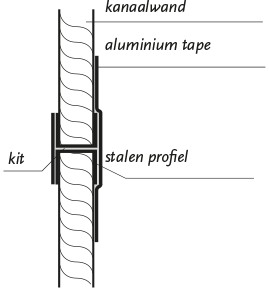
2.5.2.4 Longitudinal connections
Longitudinal connections are made as profiled seams and finished with an aluminium tape with a minimum width of 75 mm, in the case of ducts with an aluminium outer layer.
2.5.2.5 Stiffening
Air ducts are designed to be sufficiently stiff that no troublesome deformations occur. Based on the application of the recommended minimum panel thickness according to 2.5.1.2, duct surfaces with a width > 600 mm for glass wool and 1200 mm for rock wool are reinforced internally with stiffeners of galvanised material. These are attached to the duct area by means of parkers with washers. Number of stiffening profiles: 1 per 0.75 m 2wall surface for glass wool and 1 per 1.25 m2 wall surface for rock wool.
2.5.2.6 Dimensions
The nominal dimensions of the air ducts are given in mm and refer to the internal dimensions with a tolerance of ± 2 mm up to a side dimension of 1200 mm and ± 4 mm for a side dimension > 1200 mm. The dimensions are standardised according to the dimensions of rectangular metal ducts.
2.5.2.7 Execution possibilities
The execution possibilities of mineral wool air ducts are:
- -Glass wool with polyester outer layer, suitable for outdoor installation;
- -glass wool with at least 50 micron aluminium on the inside andpolyester on the outside, suitable for outdoor use;
The following specifications apply to the application of polyester:- -450 gram/m2 glass fibre for an internal duct size smaller than 700 mm;
- -2 x 450 gram/m2 glass fibre for an internal duct size equal to orlarger than 700 mm.
2.5.2.8 Bends
Bends are performed as:
- bends with an angle greater than 45° shall be fitted with blades;
- Right-angled bends are provided with blades or air turns.
2.5.2.9 Adapters
The adapters are designed in such a way that the top angle is always a maximum of 60°.
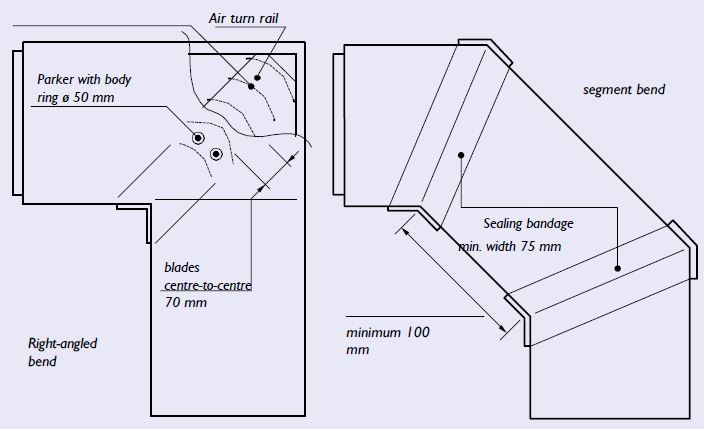
2.5.2.10 Branches
A branch (a split from a continuous main duct), can be realised by means of a straight or a flowing fitting and takes place at an angle of 90°. Aerodynamic aspects also determine the type of execution.
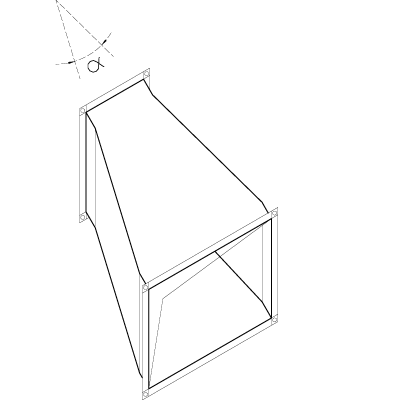

2.5.2.12 Adjustment valves
Adjustment valves are manually adjustable and serve to regulate an installation. They are provided with an appropriate locking device which also indicates the valve position. The damper blade, of the same material as the air duct, is executed in a single sheet with a thickness of at least 0.8 mm (executed according to the drawing below) up to a maximum blade width (B) of 300 mm and up to a maximum surface of 0.09 m². The edges of the damper blades are rounded and stiffened parallel to the axial direction.
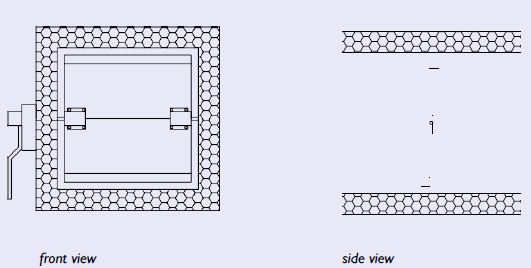
2.5.2.13 Erosion resistance
In order to guarantee erosion resistance, the ducts are internally finished with a glass fibre or aluminium embedded layer, depending on the application. The air velocity in the duct system may never exceed 12 m/s.
2.5.2.14 Smoke development, fire spread and flammability
Mineral wool ducts must be non-combustible and must at least comply with class A2 according to DIN 4102 and class 1 according to NEN-EN 13501. Smoke number ≤ 1 (smoke density negligible).
2.5.2.15 Permissible system pressure
The maximum permissible system pressure is:
- for rectangular glass wool ducts with aluminium outer layer 500 Pa;
- for rectangular glass wool ducts with polyester outer layer 1000 Pa;
- for octagonal glass wool ducts with polyester outer layer 1000 Pa;
- for rectangular stone wool ducts 850 Pa.
2.5.2.16 Operating temperature
The maximum operating temperature for glass wool ducts and stone wool ducts with steel profiles is 120° C.
2.5.2.17 Transition from mineral wool to steel
The transition from rectangular mineral wool air ducts to steel air ducts can be achieved by following three principles.
Which principle is applied depends on the desired transition.
The choice of material for the transition depends on the steel air duct to be connected, for example galvanised steel, stainless steel or aluminium.
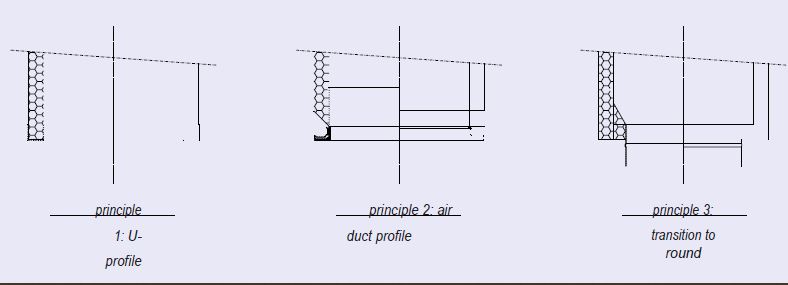
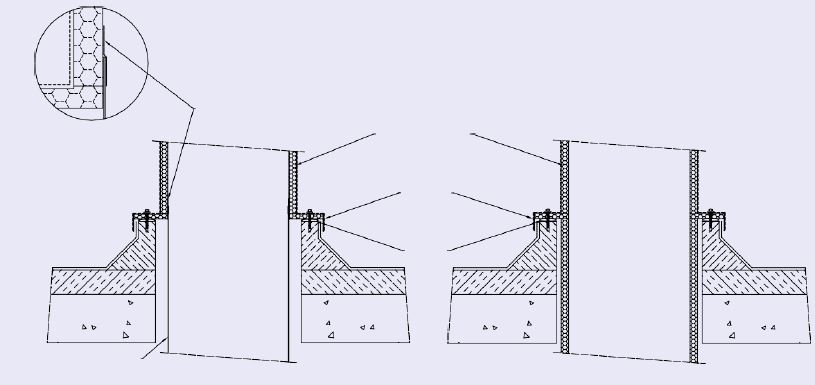
2.5.2.17 Transition from mineral wool to stee
The transition from rectangular mineral wool air ducts to steel air ducts can be achieved by following three principles.
Which principle is applied depends on the desired transition.
The choice of material for the transition depends on the steel air duct to be connected, for example galvanised steel, stainless steel or aluminium.


2.5.2.18 Connecting mineral wool air ducts to roof transits
Mineral wool ducts can be connected to roof transits by means of two principles. Which principle is applied depends on the desired situation.
Principle 1: The metal air duct extends approximately 50 mm through the roof curb. The transition from metal to mineral wool is made here. The roof transit is then finished off in a weather-proof manner.
Principle 2: The mineral wool air duct is installed below the roof structure. The mineral wool air duct is inserted through the roof curb. The roof transit is then weatherproofed. If required, the transition from plastic to metal can be made according to the principles described in chapter 2.5.1.17.


